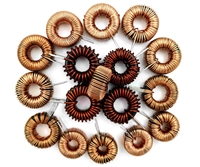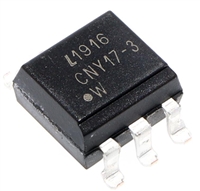CS8147
APPLICATION NOTES
Since both outputs are controlled by the same ENABLE,
This point represents the worst case input voltage
the CS8147 is ideal for applications where a sleep mode is
required. Using the CS8147, a section of circuitry such as a
display and nonessential 5.0 V circuits can be shut down
under microprocessor control to conserve energy.
The test applications circuit diagram shows an automotive
radio application where the display is powered by 10 V from
conditions.
Step 5: If the capacitor is adequate, repeat steps 3 and 4 with
the next smaller valued capacitor. A smaller capacitor will
usually cost less and occupy less board space. If the output
oscillates within the range of expected operating conditions,
repeat steps 3 and 4 with the next larger standard capacitor
value.
V
OUT1
and the Tuner IC is powered by 5.0 V from V
.
OUT2
Neither output is required unless both the ignition and the
Radio On/OFF switch are on.
Step 6: Test the load transient response by switching in
various loads at several frequencies to simulate its real
working environment. Vary the ESR to reduce ringing.
Step 7: Raise the temperature to the highest specified
operating temperature. Vary the load current as instructed in
step 5 to test for any oscillations.
Once the minimum capacitor value with the maximum
ESR is found for each output, a safety factor should be added
to allow for the tolerance of the capacitor and any variations
in regulator performance. Most good quality aluminum
electrolytic capacitors have a tolerance of ±20% so the
minimum value found should be increased by at least 50%
to allow for this tolerance plus the variation which will occur
at low temperatures. The ESR of the capacitors should be
less than 50% of the maximum allowable ESR found in step
3 above.
Stability Considerations
The secondary output V
is inherently stable and does
OUT2
not require
a
compensation capacitor. However
a
compensation capacitor connected between V
and
OUT1
ground is required for stability in most applications.
The output or compensation capacitor helps determine
three main characteristics of a linear regulator: start–up
delay, load transient response and loop stability.
The capacitor value and type should be based on cost,
availability, size and temperature constraints. A tantalum or
aluminum electrolytic capacitor is best, since a film or
ceramic capacitor with almost zero ESR can cause
instability. The aluminum electrolytic capacitor is the least
expensive solution, but, if the circuit operates at low
temperatures (–25°C to –40°C), both the value and ESR of
the capacitor will vary considerably. The capacitor
manufacturers data sheet usually provides this information.
The value for the output capacitor C2 shown in the test and
applications circuit should work for most applications,
however it is not necessarily the optimized solution.
To determine acceptable value for C2 for a particular
application, start with a tantalum capacitor of the
recommended value and work towards a less expensive
alternative part.
Step 1: Place the completed circuit with a tantalum
capacitor of the recommended value in an environmental
chamber at the lowest specified operating temperature and
monitor the outputs with an oscilloscope. A decade box
connected in series with the capacitor will simulate the
higher ESR of an aluminum capacitor. Leave the decade box
outside the chamber, the small resistance added by the
longer leads is negligible.
Step 2: With the input voltage at its maximum value,
increase the load current slowly from zero to full load while
observing the output for any oscillations. If no oscillations
are observed, the capacitor is large enough to ensure a stable
design under steady state conditions.
Step 3: Increase the ESR of the capacitor from zero using the
decade box and vary the load current until oscillations
appear. Record the values of load current and ESR that cause
the greatest oscillation. This represents the worst case load
conditions for the regulator at low temperature.
Calculating Power Dissipation in a
Dual Output Linear Regulator
The maximum power dissipation for a dual output
regulator (Figure 16) is
NJ
NJ
Nj
I
V
V
* V
* V
)
P
+
IN(max)
IN(max)
OUT1(min) OUT1(max)
D(max)
Nj
(1)
I
) V
IQ
IN(max)
OUT2(min) OUT2(max)
where:
V
V
V
is the maximum input voltage,
IN(max)
is the minimum output voltage from V
is the minimum output voltage from V
,
,
OUT1(min)
OUT2(min)
OUT1
OUT2
I
is the maximum output current, for the
OUT1(max)
application,
I
is the maximum output current, for the
OUT2(max)
application, and
I
I
is the quiescent current the regulator consumes at
Q
.
OUT(max)
Once the value of P
is known, the maximum
D(max)
permissible value of R
can be calculated:
ΘJA
150°C * T
+
A
R
QJA
(2)
P
D
The value of R
can be compared with those in the
ΘJA
package section of the data sheet. Those packages with
’s less than the calculated value in equation 2 will keep
R
ΘJA
the die temperature below 150°C.
In some cases, none of the packages will be sufficient to
dissipate the heat generated by the IC, and an external
heatsink will be required.
Step 4: Maintain the worst case load conditions set in step
3 and vary the input voltage until the oscillations increase.
http://onsemi.com
7










 压敏电阻器在直流电路中的过压保护应用探讨
压敏电阻器在直流电路中的过压保护应用探讨

 电感耐压值及其与电感大小的关系
电感耐压值及其与电感大小的关系

 CNY17F光耦合器:特性、应用、封装、引脚功能及替换型号解析
CNY17F光耦合器:特性、应用、封装、引脚功能及替换型号解析

 DS1307资料解析:特性、引脚说明、替代推荐
DS1307资料解析:特性、引脚说明、替代推荐
